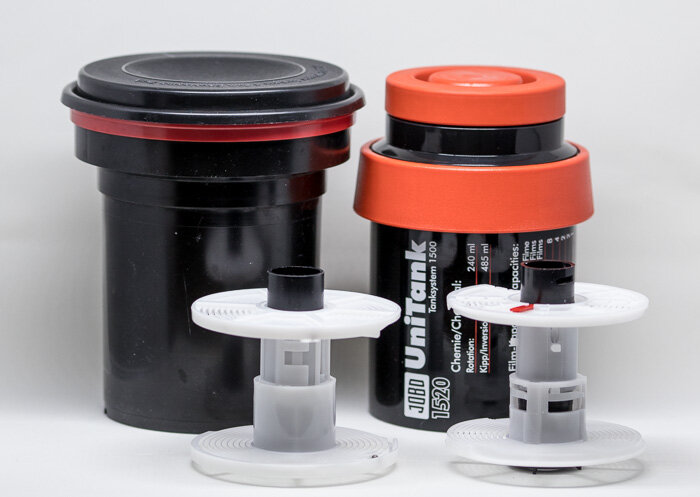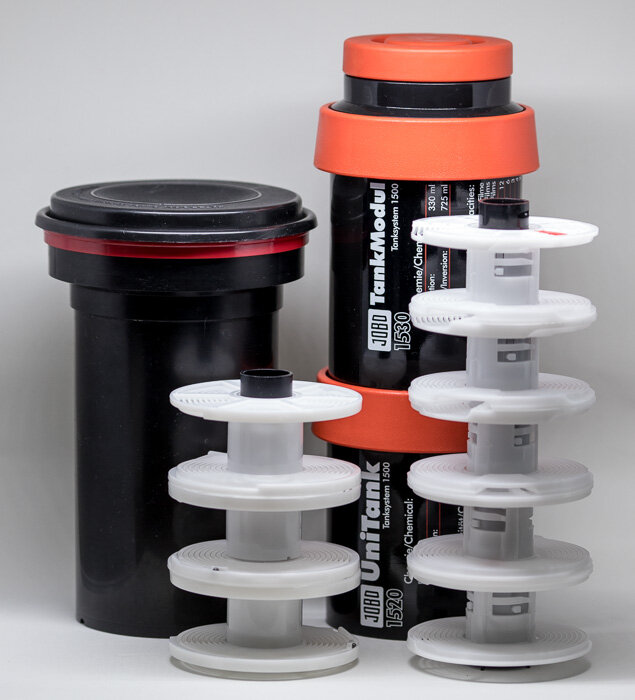Paterson vs Jobo for developing film
You are looking to develop your own negatives, and you know there’s a bunch of equipment you need to get started (here’s my quick overview of the process). Some measuring jugs, a thermometer, a dark-bag, chemicals and, of course, some developing tanks.
The two main brands are Paterson from England, and Jobo from Germany. Both are great. Here’s a guide for picking your first tank.
Paterson Tanks
Paterson tanks are inversion only. This means you use enough chemicals to completely submerge the film and you rotate the tank in your hands once a minute (or as directed). This “agitation” keeps fresh chemical in contact with the film.
The entry cost of the tanks and reels is lower than Jobo, and the reels are simple enough to load with practice. Many tank sizes are available and all use interchangeable components like the reels, funnels and caps. There is also the mod-54 which can be used in the Multi-reel-3 tank to process six sheets of 4x5 film.
I have a method where I develop two Multi-reel-3 tanks at a time, offsetting the second tank by thirty seconds which gives time to pour in developer and agitate the first tank before immediately starting on the second. This develops four medium format or six 35mm rolls in about thirty minutes.
Jobo Tanks
Jobo primarily uses continuous rotation for the agitation of the chemicals. The tanks spin about their long axis, dipping the film through chemicals that cover the bottom half of the reels. Many people avoid Jobo tanks for two reasons, both of which I’ll myth-bust here.
Jobo tanks are often seen attached to large and expensive rotation machines. These are useful for the temperature control of c-41 and e-6 color developing, but for occasional development of black and white film it can be over-kill. You can manually rotate the tanks on a Jobo roller-base, or make your own base by screwing some caster wheels onto a piece of plywood. Bonus: a home-made base means you can use Jobo tank extension combinations that some of Jobo’s motor-bases can’t cope with. You can also use the regular inversion method like with Paterson tanks, but this uses significantly more chemicals. Just make or buy a roller base.
Jobo doesn’t make a compact motor-base without the water bath. Jobo, please make a compact motor-base without the water bath! I made a gizmo that fits Jobo tanks on a vintage Uniroller motor-base, but I can’t image many people having the motivation to make this themselves.
Jobo tanks and reels are more expensive than Paterson. But Jobo tanks use a fraction of the chemicals so the costs even out quickly and there is much less chemical waste.
Jobo has some interesting positive aspects that I didn’t know about until I bought one.
The reels have a red tab that allow two rolls of 120 medium format film to be loaded on one reel (so twice the film, with half the chemicals!). Still only one 35mm roll per reel.
There are different base-tank sizes, but the real benefit comes from extension modules that you fit between your base and the lid. This means you can easily create the best-sized tank for the number of rolls you are developing in a batch.
Most people getting into developing will be well served by the 1500 system. Jobo also make a larger diameter 2500 system which uses the same inner-cores, but wider reels and the ability to use 4x5 reels.
The 2500 system can be used for developing darkroom prints. They have a 2800 system specifically for prints which is almost identical to the 2500 except it uses a light-trap cup rather than the inner-core used for film reels. All 2500 and 2800 parts are interchangeable.
The system gets more convenient when you have the money and the space for a motor processor machine.
There is one major negative though. Continuous agitation on a manual roller base requires your attention on one tank for the entire time. If you are doing multiple film stocks with different developing times, they need to be done one after the other, rather than at the same time like I described above with two Paterson tanks. For three or four rolls, Paterson developing is quicker in this regard.
Tank stats: Haw many rolls and how much chemical?
With Paterson or Jobo, avoid the smallest tanks that only do one roll of 35mm film. The next size up will do two 35mm rolls or at least one 120 medium format roll. This is significantly more useful because you can still do a single 35mm roll in them if you have to.
Paterson universal tank with two reels, $34. Can do two 35mm or one 120 roll. 580ml or 500ml respectively of chemicals using inversion.
Jobo 1520 with one reel, $68 (extra reel, $27). Can do two 35mm or two 120 rolls. 240ml of chemicals using rotation (or 485ml for inversion).
Assuming you have this kit and you want to do more film in a single batch, you’ll need a separate Paterson tank or an Jobo extension module.
Paterson Multi-reel-3, $38 (extra reel, $12). Can do three 35mm or two 120 rolls. 1000ml of chemical using inversion.
Jobo module 1530, $45 (another reel, $27). Can do five 35mm or six 120 rolls. 570 ml chemical using rotation.
Lets go crazy and develop more rolls.
Paterson Multi-reel 5, $45 (two more reels, $24). Can do five 35mm or three 120 rolls. 1500ml of chemical using inversion.
Another Jobo module 1530, $45 (another two reels, $54). Can do eight 35mm or ten 120 rolls. 900 ml chemical using rotation.
This Jobo 1520+1530+1530 is a monster that could burn out the smaller Jobo machines. On a manual base its fine. But think about it: ten medium format rolls in the same time, and using less developer volume than two rolls in a Paterson tank! Make sure 900ml of your developer can cope with ten rolls without exhausting itself. Ilfosol-3 and HC-110 dilution B seem to be fine with it.
Example Costs
It is clear that Paterson is cheaper to get you up and running, and that Jobo can save a massive amount of time and chemicals. A rough cost estimate for black and white chemicals are $3.50 for 1000ml of developer (one-shot), stop (reused for 20 rolls) and fixer (reused for 10 rolls).
Two rolls of 35 film:
Paterson Universal = $34, chemicals = $1.85
Jobo 1520 + reel = $95, chemicals = $0.90
Two rolls of 120 film:
Paterson Multitank-3 + reels = $62, chemicals = $1.75
Jobo 1520 = $68, chemicals = $0.90
Four rolls of 120 film:
Paterson Multitank-3 x2 + reels = $124, chemicals = $7
Jobo 1520+1530 + reels (four rolls in a six-roll tank) = $140, chemicals = $2
In only a few batches, the cost Jobo saves from chemicals covers the difference in equipment cost.
Bottom line
I used Paterson tanks for years developing hundreds of rolls and would recommend them in a heartbeat to anyone getting started, knowing they will only occasionally develop one or two rolls. Also, the mod-54 is a great and cost effective way to develop large format 4x5 sheets.
If you see yourself developing more rolls, or more often, then the Jobo tanks are a better long-term investment.








